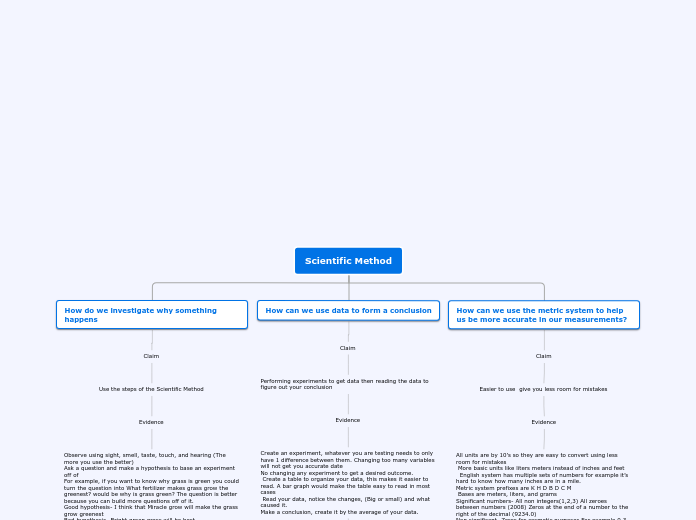
Claim
Use the steps of the Scientific Method
Evidence
Observe using sight, smell, taste, touch, and hearing (The more you use the better)
Ask a question and make a hypothesis to base an experiment off of
For example, if you want to know why grass is green you could turn the question into What fertilizer makes grass grow the greenest? would be why is grass green? The question is better because you can build more questions off of it.
Good hypothesis- I think that Miracle grow will make the grass grow greenest
Bad hypothesis- Bright green grass will be best
Experiment and run multiple tests only changing one thing at a time. Take 3 pots of dirt with the same amount and type of grass seed. Give them the same amount of water and conditions every day. Give each pot of grass the same amount of fertilizer, but use 3 different kinds. Run this test multiple times and record your results.
The dependent variable is what you record, the independent variable will be what you change, and the constants are what you will not change. Control is what information you are building off of.
Collect data and make a conclusion
Connection
In the past I have made experiments to see what temperatures my fish tank thrive on. I had a range to begin with, but I had to experiment by changing the temperature about once every other week to find out what temperature they did best with. I had to observe to see if it had positive or negative changes in the fish, frogs, and snails.
Vocab
Observation- Information gathered using the 5 senses
Hypothesis- educated guess
Independent- What you change
Dependent- What is measured
Constant- remains the same
Control- Reference
Claim
Performing experiments to get data then reading the data to figure out your conclusion
Evidence
Create an experiment, whatever you are testing needs to only have 1 difference between them. Changing too many variables will not get you accurate date
No changing any experiment to get a desired outcome.
Create a table to organize your data, this makes it easier to read. A bar graph would make the table easy to read in most cases
Read your data, notice the changes, (Big or small) and what caused it.
Make a conclusion, create it by the average of your data.
Connection
When testing what temperature worked the best for all of the critters in my fish tank, I could only change the temperature. If I changed anything else, that could throw off the results for how they react to different temperatures. To get data, I would pay attention to the changes in their behavior, were they slower and more fatigued or were they more active and alert. After watching all of them, I could make a conclusion on what temperature was the best for them all to live in together
Vocab
Hypothesis- educated guess
Independent- What you change
Dependent- What is measured
Constant- remains the same
Control- Reference
Claim
Easier to use give you less room for mistakes
Evidence
All units are by 10’s so they are easy to convert using less room for mistakes
More basic units like liters meters instead of inches and feet
English system has multiple sets of numbers for example it’s hard to know how many inches are in a mile.
Metric system prefixes are K H D B D C M
Bases are meters, liters, and grams
Significant numbers- All non integers(1,2,3) All zeroes between numbers (2008) Zeros at the end of a number to the right of the decimal (9234.0) Non significant- Zeros for cosmetic purposes For example 0.3 Zeros only used to locate the decimal point 0.0000767686
Connection
When measuring how far I need to run on the track it is easier to say 1400 meters than 4593.176 feet
Vocab
Volume- how much space an object occupies